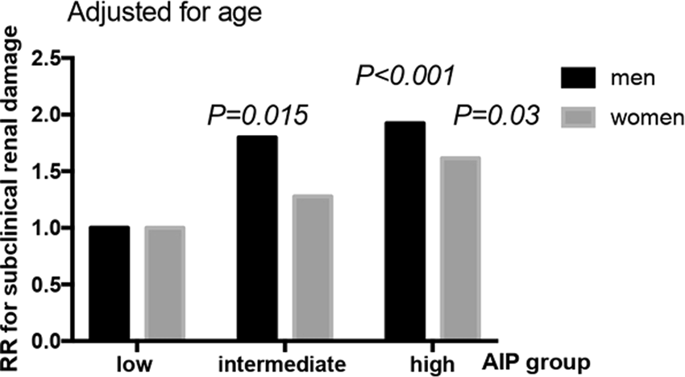当前位置:
X-MOL 学术
›
Eur. J. Clin. Nutr.
›
论文详情
Our official English website, www.x-mol.net, welcomes your
feedback! (Note: you will need to create a separate account there.)
Association between atherogenic index of plasma and subclinical renal damage over a 12-year follow-up: Hanzhong adolescent hypertension study.
European Journal of Clinical Nutrition ( IF 3.6 ) Pub Date : 2019-11-14 , DOI: 10.1038/s41430-019-0530-x Yue Yuan 1, 2 , Jia-Wen Hu 1, 2 , Yang Wang 1, 2 , Ke-Ke Wang 1, 2 , Wen-Ling Zheng 1, 2 , Chao Chu 1, 2 , Qiong Ma 1, 2 , Yu Yan 1, 2 , Yue-Yuan Liao 1, 2 , Jian-Jun Mu 1, 2
European Journal of Clinical Nutrition ( IF 3.6 ) Pub Date : 2019-11-14 , DOI: 10.1038/s41430-019-0530-x Yue Yuan 1, 2 , Jia-Wen Hu 1, 2 , Yang Wang 1, 2 , Ke-Ke Wang 1, 2 , Wen-Ling Zheng 1, 2 , Chao Chu 1, 2 , Qiong Ma 1, 2 , Yu Yan 1, 2 , Yue-Yuan Liao 1, 2 , Jian-Jun Mu 1, 2
Affiliation

|
BACKGROUND
A high atherogenic index of plasma (AIP) is associated with increased cardiovascular risk and higher serum uric acid levels, but whether AIP is a strong risk factor for developing subclinical renal damage (SRD) is unknown. This study aimed to explore the effect of AIP variations on the prevalence of SRD in a 12-year follow-up study.
METHODS
(1) The cross-sectional study enrolled 2485 participants from the Hanzhong cohort in 2017; (2) A total of 202 participants were included in the small longitudinal cohort from 2005 to 2017. Longitudinal analysis was used to determine whether an elevated AIP predicts the development of SRD.
RESULTS
In the cross-sectional analysis, the AIP level was correlated with the estimated glomerular filtration rate (eGFR) and urinary albumin-to-creatine ratio (uACR) (P < 0.05). The age-adjusted odds ratio (OR) for prevalent SRD in men in the high AIP group was 1.924 (1.355-2.732) (P < 0.001), while in women, the OR was 1.616 (1.049-2.490) (P = 0.030) in the high AIP group. In the longitudinal analysis, significantly higher uACR levels were found in participants with normal AIP at baseline and elevated AIP in 2013 (P < 0.05). The adjusted OR for prevalent SRD in the incident AIP group was 4.741 (1.668-13.472) (P = 0.003) compared with the control group.
CONCLUSIONS
Our study indicates that elevated AIP increased the risk of developing SRD and was associated with uACR and eGFR. As a simple marker of CVD risk, AIP may emerge as a novel and reliable indicator of SRD.
中文翻译:

一项为期12年的随访显示,血浆动脉粥样硬化指数与亚临床肾损害之间的关联:汉中市青少年高血压研究。
背景技术血浆高动脉粥样硬化指数(AIP)与心血管风险增加和血清尿酸水平升高有关,但尚不清楚AIP是否是发展为亚临床性肾损害(SRD)的强大危险因素。这项研究旨在探讨一项为期12年的随访研究,探讨AIP变异对SRD患病率的影响。方法(1)横断面研究招募了2017年汉中队列研究的2485名参与者; (2)从2005年到2017年,共有202名参与者参加了小型纵向队列研究。采用纵向分析来确定AIP升高是否预示了SRD的发生。结果在横断面分析中,AIP水平与估计的肾小球滤过率(eGFR)和尿白蛋白/肌酸比(uACR)相关(P <0.05)。高AIP组男性中SRD的年龄调整后的优势比(OR)为1.924(1.355-2.732)(P <0.001),而女性的OR为1.616(1.049-2.490)(P = 0.030)在高级AIP组中。在纵向分析中,2013年基线时AIP正常且AIP升高的参与者的uACR水平显着升高(P <0.05)。与对照组相比,入射AIP组中SRD的校正OR为4.741(1.668-13.472)(P = 0.003)。结论我们的研究表明,升高的AIP会增加发生SRD的风险,并与uACR和eGFR相关。作为CVD风险的简单指标,AIP可能会成为SRD的一种新颖而可靠的指标。030)。在纵向分析中,基线时AIP正常且AIP升高的参与者在2013年的uACR水平显着升高(P <0.05)。与对照组相比,入射AIP组中SRD的校正OR为4.741(1.668-13.472)(P = 0.003)。结论我们的研究表明,升高的AIP会增加发生SRD的风险,并与uACR和eGFR相关。作为CVD风险的简单指标,AIP可能会成为SRD的一种新颖而可靠的指标。030)。在纵向分析中,基线时AIP正常且AIP升高的参与者在2013年的uACR水平显着升高(P <0.05)。与对照组相比,入射AIP组中SRD的校正OR为4.741(1.668-13.472)(P = 0.003)。结论我们的研究表明,升高的AIP会增加发生SRD的风险,并与uACR和eGFR相关。作为CVD风险的简单指标,AIP可能会成为SRD的一种新颖而可靠的指标。结论我们的研究表明,升高的AIP会增加发生SRD的风险,并与uACR和eGFR相关。作为CVD风险的简单指标,AIP可能会成为SRD的一种新颖而可靠的指标。结论我们的研究表明,升高的AIP会增加发生SRD的风险,并与uACR和eGFR相关。作为CVD风险的简单指标,AIP可能会成为SRD的一种新颖而可靠的指标。
更新日期:2019-11-14
中文翻译:

一项为期12年的随访显示,血浆动脉粥样硬化指数与亚临床肾损害之间的关联:汉中市青少年高血压研究。
背景技术血浆高动脉粥样硬化指数(AIP)与心血管风险增加和血清尿酸水平升高有关,但尚不清楚AIP是否是发展为亚临床性肾损害(SRD)的强大危险因素。这项研究旨在探讨一项为期12年的随访研究,探讨AIP变异对SRD患病率的影响。方法(1)横断面研究招募了2017年汉中队列研究的2485名参与者; (2)从2005年到2017年,共有202名参与者参加了小型纵向队列研究。采用纵向分析来确定AIP升高是否预示了SRD的发生。结果在横断面分析中,AIP水平与估计的肾小球滤过率(eGFR)和尿白蛋白/肌酸比(uACR)相关(P <0.05)。高AIP组男性中SRD的年龄调整后的优势比(OR)为1.924(1.355-2.732)(P <0.001),而女性的OR为1.616(1.049-2.490)(P = 0.030)在高级AIP组中。在纵向分析中,2013年基线时AIP正常且AIP升高的参与者的uACR水平显着升高(P <0.05)。与对照组相比,入射AIP组中SRD的校正OR为4.741(1.668-13.472)(P = 0.003)。结论我们的研究表明,升高的AIP会增加发生SRD的风险,并与uACR和eGFR相关。作为CVD风险的简单指标,AIP可能会成为SRD的一种新颖而可靠的指标。030)。在纵向分析中,基线时AIP正常且AIP升高的参与者在2013年的uACR水平显着升高(P <0.05)。与对照组相比,入射AIP组中SRD的校正OR为4.741(1.668-13.472)(P = 0.003)。结论我们的研究表明,升高的AIP会增加发生SRD的风险,并与uACR和eGFR相关。作为CVD风险的简单指标,AIP可能会成为SRD的一种新颖而可靠的指标。030)。在纵向分析中,基线时AIP正常且AIP升高的参与者在2013年的uACR水平显着升高(P <0.05)。与对照组相比,入射AIP组中SRD的校正OR为4.741(1.668-13.472)(P = 0.003)。结论我们的研究表明,升高的AIP会增加发生SRD的风险,并与uACR和eGFR相关。作为CVD风险的简单指标,AIP可能会成为SRD的一种新颖而可靠的指标。结论我们的研究表明,升高的AIP会增加发生SRD的风险,并与uACR和eGFR相关。作为CVD风险的简单指标,AIP可能会成为SRD的一种新颖而可靠的指标。结论我们的研究表明,升高的AIP会增加发生SRD的风险,并与uACR和eGFR相关。作为CVD风险的简单指标,AIP可能会成为SRD的一种新颖而可靠的指标。











































 京公网安备 11010802027423号
京公网安备 11010802027423号